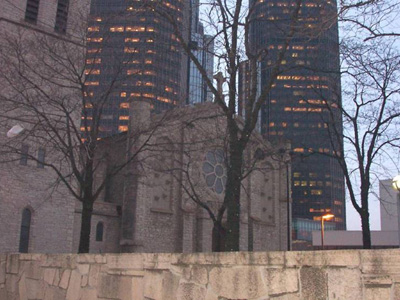 |
|

The church: Mariners' Church of Detroit (also known as the Maritime Sailors' Cathedral), Detroit, Michigan, USA.
Denomination: Independent Anglican (formerly Episcopal Church in the USA).
The building: A rectangular stone gothic revival building, seating about 300 (estimate), with two subterranean levels for Sunday School and other parish activities. It is decorated in a definite nautical theme, including a model of a ship near the altar, flags hanging in the nave, and the words to the sailors' hymn Eternal Father, Strong to Save in the window above the altar and reredos.
The church: Founded originally as a ministry to maritime transients, the church now draws its congregants from the greater Detroit metropolitan area. Many (but not all) have some nautical connection. The church is perhaps best known for its mention in the Gordon Lightfoot song The Edmund Fitzgerald, commemorating the tragic loss of that ship and its crew in a storm on the Great Lakes. The church's calendar includes that event as well as others of a nautical nature (blessing of ships, etc.). Its other defining moment seems to have been the winning of the lawsuit to keep their building when they split from the Episcopal diocese 15 years ago – the pamphlet rack still carries literature concerning that event.
The neighborhood: The church's immediate neighbors include the Detroit-Windsor International Tunnel entrance, which snakes around the building. The tunnel is the word's only underwater international border crossing for motorcars. Other landmarks in the area include General Motors world headquarters, Hart Plaza (the civic park) and the Convention Center.
The cast: The Rt Rev. Richard W. Ingalls, bishop and rector; the Rev. Richard W. Ingalls, Jr., assitant rector; the Rev. Deacon Jesse Roby; Kenneth Sweetman, organist and choirmaster; Emily Benner, cantor.
Requiem Eucharist.
How full was the building?
About 60 people – one-fifth full.
Did anyone welcome you personally?
The ushers said good morning, handed me a bulletin, and asked if I had parked in the civic park garage (apparently there is only validated parking on Sunday – but I had walked there from my office).
Was your pew comfortable?
Yes, wood pew with cushions and a kneeler that folded down from the pew ahead.
How would you describe the pre-service atmosphere?
Quiet, prayerful, with a soft prelude being played.
What were the exact opening words of the service?
"Let us pray: Almighty God, unto whom all hearts are open, etc." – this after the Burial Sentences were sung.
What books did the congregation use during the service?
1928 Book of Common Prayer; 1940 Hymnal.
What musical instruments were played?
Organ.
Did anything distract you?
Big: The constant bass thump, thump, thump of the Detroit Electronic Music Festival, which was being held in the neighboring park. Small: Local adaptations of the liturgy, such as having the congregation recite together a section of the eucharistic canon, and the placement of the benedictus qui venit after the eucharistic canon rather than the end of the sanctus. Nothing to invalidate the service, but it made me curious as to the history of this local custom.
Was the worship stiff-upper-lip, happy clappy, or what?
Solid, traditional Anglican with very good hymn singing.
Exactly how long was the sermon?
24 minutes.
On a scale of 1-10, how good was the preacher?
7 – It was actualy four separate eulogies about the deceased, including one by the husband and one by the son. Although multiple eulogies can be a real disaster, all four speakers were pretty good and quoted lots of biblical references.
In a nutshell, what was the sermon about?
One eulogist spoke about the biblical principle of hope in the resurrection; another about how the deceased had expressed joy in the Lord, usually with a song in her heart. The third speaker held the deceased up as an example of patient suffering; and the last spoke about her abiding faith in the Lord and faithfulness to her friends.
Which part of the service was like being in heaven?
The cantor's rendition of Pie Jesu from Faure's Requiem.
And which part was like being in... er... the other place?
Hearing the thumping of the techo-music festival penetrating the walls of the building!
What happened when you hung around after the service looking lost?
No chance – I was recognized by others in the church, the assistant rector, and the family of the deceased.
How would you describe the after-service coffee?
No coffee. Some went off to the cemetery and I went back to work.
How would you feel about making this church your regular (where 10 = ecstatic, 0 = terminal)?
7 – If I could get over the idea of a parish being Anglican yet independent.
Did the service make you feel glad to be a Christian?
Yes.
What one thing will you remember about all this in seven days' time?
The contradiction between the glorious church music and the thumping bass line of the techno-festival outside.
| The Mystery Worshipper is sponsored by surefish.co.uk, the internet service provider from Christian Aid. By offering email services, special offers with companies such as amazon.co.uk and smile.co.uk, surefish raises more than £300,000 a year for Christian Aid's work around the world. Click here to find out how to become a Mystery Worshipper. And click here if you would like to reproduce this report in your church magazine or website. Top | Other Reports | Become a Mystery Worshipper! © Ship of Fools 2005 |